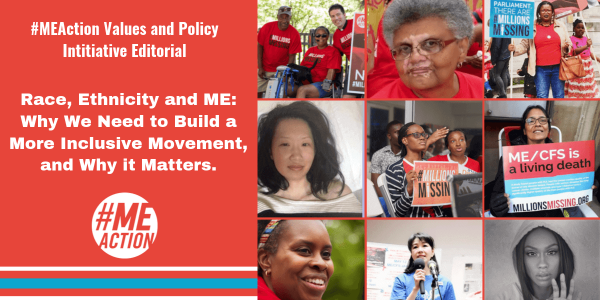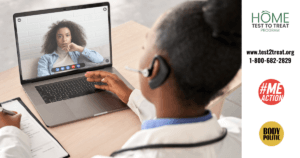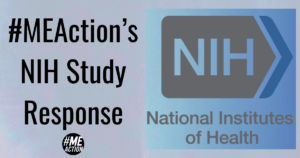Values & Policy Initiative
This article is part of our Values & Policy Initiative, a six-month long process for the community to come together to learn and discuss our core values, tactics and positions so that we are more unified in our work as a large, diverse community. This process will culminate in a statement of principles and values as well as a formal policy platform, which the community will ratify with an up-or-down vote. Visit our Values & Policy webpage to see published articles, and our timeline for discussion. #MEActionVPI
Join our upcoming Community Call to discuss our values and tactics on Wednesday, October 30th at 10 am PT / 1 pm ET / 6 pm UK
#MEAction speaks with Wilhelmina Jenkins about the historic perception of myalgic encephalomyelitis (ME) as a wealthy white women’s disease, how that stigma has made it more difficult for communities of color to get diagnosed and treated for ME, and the importance of building a movement that is representative of the entire ME population.
If research shows that ME affects people of all races and ethnicities, why has popular culture depicted it as a “white women’s disease?”
Here in the U.S., the erroneous depiction of this disease goes back its early mischaracterization by those at the Centers for Disease Control and Prevention (CDC) as a trivial condition that was a form of depression experienced almost exclusively by white people, primarily women. This false impression was reinforced by the trivializing name given to this disease in this country – chronic fatigue syndrome.
In the late ’80s, there were numerous articles written about this disease, driven largely by the fear that this could be “another AIDS”. Each of these articles was accompanied by a young or middle aged, tired looking white woman. These images became the face of this disease. Government officials and some researchers reinforced this false image when they gave interviews about this disease, even speculating about why only white people were affected. This, of course, was entirely untrue.
Some patient organizations were aware of the discrepancy between the images being presented and the reality of who was affected and made efforts to be sure that African Americans were included in all publications and presentations concerning this disease but, in the pre-internet days, it was difficult to counteract the images in the larger media.
Dr. Leonard Jason, in his community-based studies in the late ’90s, showed conclusively that the prevalence of this disease was at least as high among African Americans and Latinos as it is among whites. At that point, the CDC acknowledged the correct statistics, but did nothing to assure that the correct information reached clinicians serving diverse populations.
How does this perception of the disease affect people of color with ME?
Many people of color and the primary care doctors who care for them are unaware that this disease affects all racial and ethnic groups, and can be even more devastating than more commonly diagnosed diseases. As a result, people of color are being diagnosed with ME/CFS at numbers far lower than their percentage of the population would indicate.
Living with ME/CFS is extremely difficult under any conditions, but living with this disease undiagnosed is a nightmare. While there are still no universally accepted treatments for this disease, knowledgeable physicians can help in managing the complex array of symptoms. In addition, those who are aware that this disease is the reason that they are so very ill can seek support and affirmation from others living with the disease.
If people of color do not see images of people of their own race and ethnicity with this disease, they are unlikely to consider ME/CFS as the source of their suffering. If the overworked physicians who care for underserved communities are not informed about how severe this disease can be and how they can recognize it in their patient populations, those patients will be left to struggle alone. When medicine cannot provide answers, those affected are likely to resort to self-blame, self medication, or even suicide. The results can be disastrous.
What are some of the obstacles to diagnosis and treatment that are specific to communities of color that the ME community should address?
In my opinion, one of the greatest obstacles is the lack of information provided to the medical professionals caring for underserved populations. Many African American people, regardless of socioeconomic level, prefer to see physicians of their own ethnicity or who have a diverse patient population. The same is probably true for other underserved ethnicities. Frequently these medical professionals are overworked and have less time to spend with each patient. They are often located in high density population areas and serve a clientele living with a larger than average number of chronic diseases. Unless an authority like the CDC alerts them about the severity of this disease and that it will not be uncommon among the people that they treat, they will not consider a diagnosis of ME/CFS.
Another barrier is the lack of faith in the medical community that is seen in many ethnic groups. This lack of faith has deep historical roots. Most people who are diagnosed with ME/CFS receive that diagnosis after seeing a number of doctors. Many in the African American and other ethnic communities will follow the advice of a family doctor whom they trust and not seek additional opinions.
For Latinx people, language can be a severe barrier. There are few Spanish language materials on ME/CFS and those doctors who do know about this disease may not be sufficiently fluent in Spanish to communicate well with their patients.
There is a socioeconomic barrier that affects people of all ethnicities who do not have the resources to see ME/CFS specialists who frequently do not accept insurance, especially Medicare and Medicaid. In addition, African American and Latinx people with ME/CFS may be more reluctant to utilize precious family resources until a cure, or at least good treatments, are available and affordable.
Why is it important to create a movement that is representative of the entire ME population?
In my opinion, any grassroots movement needs to be representative of the population that is affected. Without a representative number of people from all groups affected by ME/CFS – including all genders, ethnicities, ages, and socioeconomic groups – we will not have a full and accurate picture of this disease. Researchers who do not include a diverse population in their cohorts may be missing important clues as they try to understand this disease. Advocacy groups will be richer by including the perspectives and experiences of a diversity of ethnic groups.
In addition, there are healthy allies who can help with this struggle if they understand the breadth of the community that is affected. Black womens’ health advocacy groups, Latinx health advocacy groups, and even African American and Latinx social groups may be willing to stand with us. The Congressional Black Caucus and Congressional Hispanic Caucus may be supportive of legislative efforts for ME/CFS.
In ME advocacy work, what have you seen done well towards achieving the goal of creating a more a more racially and ethnically inclusive community? What are some of the areas we must work on?
Two of the most effective tools that I have seen for outreach to a diverse population have been the film Unrest and Jen Brea’s TED talk. Because Jen is biracial, many people who had not previously been connected with the ME/CFS community saw themselves in her and reached out.
What I hope that #MEAction can do is to make a concerted effort to organize and support the people of color with ME/CFS with whom we are now connected. Those efforts have begun, but they need to be strengthened. I have found #MEAction to be a very supportive and encouraging community, but if there are others who feel that their voices are being dismissed or unheard, every effort should be made to assure them that this community welcomes and supports diverse voices.
#MEAction has made a good effort to include diverse images and stories in its media posts and publications. I would like to see that effort strengthened and more stories spotlighted. Our stories are powerful, and the more diverse they can be, the better. The images presented should be of real people of all ethnicities who live with this disease.
In addition, I would like to see #MEAction make a stronger effort to push government agencies to create a serious outreach effort toward physicians in underserved communities. I do not believe that those physicians will take this disease as seriously as they do diabetes or heart disease unless there is a push by the US government agencies.
Every government health agency has a department that deals with health disparities. For example, NIH has the National Institute on Minority Health and Health Disparities that is represented on the Trans-NIH ME/CFS Working Group. CDC has an Office of Minority Health and Health Equity. I would like to see #MEAction meetups with these groups to utilize their experience in tackling health disparities. My opinion is that the US government played a significant role in creating the false images about this disease and it has a serious responsibility in tearing them down.
In terms of the African American community in particular, I would like to see outreach jointly by #MEAction and government agencies to the historically Black medical organizations and medical schools. There are three historically Black medical schools, two of which are close to CDC and NIH, respectively. We need to establish a dialogue with these schools so that their graduates will be well prepared to diagnose and care for their patients who live with ME/CFS, and their researchers will consider applying for research grants to study this disease in their patient populations.
Finally, I would like to see more diversity at every level of #MEAction, from the board to the group moderators to the volunteers. I understand that this is not easy; poor rates of diagnosis mean a less diverse community from which leadership can be chosen. But a commitment to diversity has to come from the top. There are people of color with ME/CFS who would be a valuable asset to #MEAction’s leadership. I hope that, as they emerge, they are encouraged as much as possible.
Visit our Values & Policy webpage to read published articles, see the timeline for discussion and join community calls. #MEActionVPI
About the Author:
Wilhelmina Jenkins was finishing her PhD in physics, and looking forward to a long, happy career in science when she struck and completely disabled by ME in 1983. She has been advocating for change for ME – research and clinical care – ever since. Wilhelmina is currently an activist with #MEAction, volunteering as a key organizer with #MEAction Georgia, with #MEAction’s CDC Committee, and with #MEAction’s People of Color with ME Group.







6 thoughts on “Race, Ethnicity and M.E.: Why We Need to Build a More Inclusive Movement and Why it Matters.”
Critical essay for the health of our organization.
Excellent interview. This very interview can be used as an out reach tool.
Thanks so much for this interview! I too think practicing and striving for greater racial equity and anti-racism, within the #MEAction community and in external/advocacy efforts, should be central.
Thank you, Wilhelmina!
You recently such down a conversation about religious beliefs that was pleasant ,informative, and non offensive to anyone’s beliefs. So what’s the next censor? These things are important to chronically ill people. Are any of you chronically ill? Sometimes a little power is curruptive and when you have absolute power over our words even though they are respectful, then you have absolutely corrupted the purpose of giving us knowledge and friends. If someone is not interested in the subject they are not required to read it.
Wendy, which conversation are you referring to? Where did it take place – on our FB page, Twitter or one of our FB groups?
Most of our team has ME – 5 of 8 members have ME, all of varying degrees of severity. Many of us having recovered enough to work part-time or full-time.
Comments are closed.